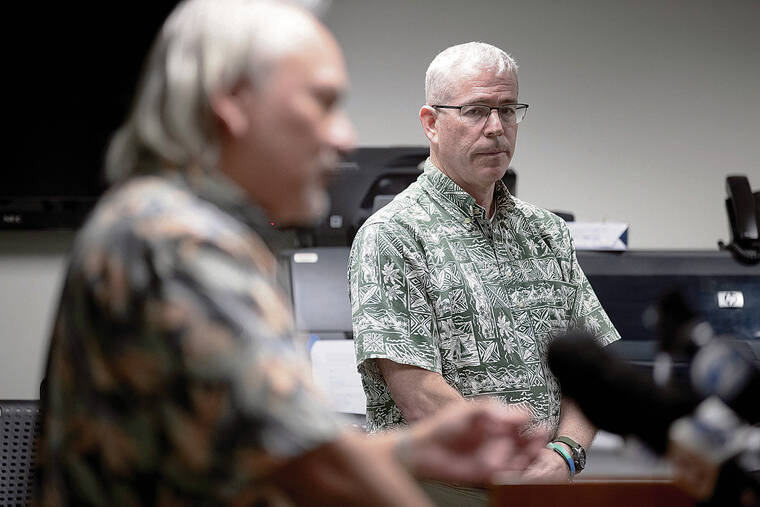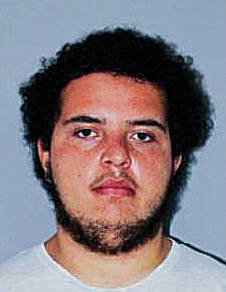State psychiatric hospital operations are in a 48-hour safety stand-down with heightened staffing after officials said a nurse employed by the state in a transitional group home on the hospital’s campus in Kaneohe was fatally stabbed by a patient Monday evening.
The death of Justin Bautista is the only known instance of a worker on the Hawaii State Hospital campus being killed by a patient, according to Kenneth Luke, the hospital’s administrator.
Bautista, 29, had worked at the State Hospital for four years.
“What happened yesterday was tragic and extremely sad,” Kenneth Fink, director of the state Department of Health, said Tuesday. “Our Department of Health ohana is in mourning, and our thoughts and our prayers are with Justin’s loved ones.”
The suspect in the case, Tommy Kekoa Carvalho, was arrested by police Monday on suspicion of second-degree murder, and had been a patient in the hospital’s secure facility until August when he was transferred to the transitional group home based on what Luke said was a unanimous decision by an independent panel of clinicians and court approval.
The group home where Bautista worked and Carvalho was living is known as the State Operated Specialized Residential Program. This facility provides occupants with treatment programs and has 24-hour supervision. Occupants also can earn privileges to leave and return.
Luke said the SOSRP provides a higher level of supervision and treatment compared with traditional group homes, which can be in residential communities, and represents an intermediate step for transitioning appropriate patients from secured hospitalization back into the community.
“It’s sort of a bridge for people who don’t need the hospital, but we want to give them a small step to get ready to go back into the community,” Luke said.
Fink said the SOSRP, which has capacity for 22 residents, had 21 and was fully staffed Monday evening with five employees. Those employees were three psychiatric technicians, one registered nurse and Bautista, a licensed practical nurse. At night the SOSRP staff drops to three from five.
Luke said any ideas the public might have that the accused killer was prematurely moved from the hospital, which is overcrowded, to the SOSRP are false.
“The clinical teams are highly responsible, the courts are conservative and the independent examiners are independent,” Luke said.
Fink, who spoke at a news conference Tuesday with Luke, added, “Patients go through a very thorough process to evaluate and determine if they are suitable for a different level of care. So for (the suspect) to have been in that level of care required that multiple clinicians determined him to be appropriately cared for in that setting.”
HDOH plans to conduct a clinical review of the case.
The United Public Workers union, which represents employees in a bargaining unit that included Bautista, said members’s safety and well-being are of utmost importance.
“We are deeply saddened by the tragic news of the fatal stabbing of a staff member at the Hawaii State Hospital,” Kalani Werner, UPW’s state director, said in a statement. “Our hearts go out to his family, friends, and all those affected by this senseless loss. … Every worker deserves to feel safe and secure in their workplace, and we are committed to advocating for policies that ensure just that.”
The State Hospital in Kaneohe is primarily for patients with mental health issues who have been ordered there by the courts after committing minor or serious crimes, or while awaiting evaluations on whether they are mentally fit to stand trial.
According to court records, Carvalho, 25, was charged in 2016 with three counts of felony terroristic threatening on Kauai and acquitted in 2017 due to mental incapacity. He then was sent to the State Hospital.
Records also show that in 2020, Carvalho was charged with and found guilty of assaulting a state mental health worker, Jason Chung.
Court records indicate that Carvalho was granted conditional release from the hospital and then recommitted on multiple occasions. All told, he was ordered to the State Hospital four times, and most recently spent a year at the secure facility until August.
Treating patients who sometimes relapse is not uncommon in the mental health system.
Luke described Monday’s deadly incident as unanticipated and unprovoked. “We did not see evidence that this was going to happen,” he said.
The State Hospital by its nature involves risk to employees, according to HDOH.
According to annual reports by the agency on operations of the hospital, not including the SOSRP, assaults on staff have ranged over the past decade from 63 to 151 per year.
The low was in fiscal year 2016, and the high was in fiscal year 2020. In fiscal years 2021 and 2022, which was the last report available, there were 122 assaults in each year.
Luke said the hospital has become safer with a decline in assaults since a new, 144-bed main facility that cost $160 million opened gradually in 2022.
However, the new building and older facilities that are also part of the hospital are overcrowded. The standard capacity is 297 patients, yet 325 patients are there under a temporary capacity limit of 350, according to Luke.
The hospital in recent decades has been plagued with operational troubles, including lax security, staff shortages and high rates of assault by patients against staff.
In 2017, Randall Saito, a patient who was sent to the hospital in 1981 after being acquitted of murder by reason of insanity, walked out of the facility, called a taxi that took him to the airport, and boarded a chartered flight to Maui and then a commercial flight to San Jose, Calif.
Another patient escaped in 2022 and was captured after one day.
The new hospital building was scheduled to open in 2021 but sat empty for more than a year amid problems with construction quality and concerns over design.
In 2021 the Hawaii Government Employees Association, which represents some workers at the hospital, told the Honolulu Star-Advertiser that it had concerns over state officials not planning to operate the new building like a prison housing people with mental illness.
In August, Luke, who at the time was the hospital’s acting administrator, announced the firing of the hospital’s three senior managers and said leadership would be restructured as part of an effort to overcome challenges with maintaining quality care in a safe and therapeutic environment while managing ever-increasing demand for services.
Luke became administrator in October.
During the safety stand-down, the number of staff for the SOSRP facility is being increased to seven from five during shifts from daytime into the evening, and to five from three at night.
HDOH is also providing staff with emotional support and references to counseling services.
———
Star-Advertiser staff writer Leila Fujimori contributed to this story.






